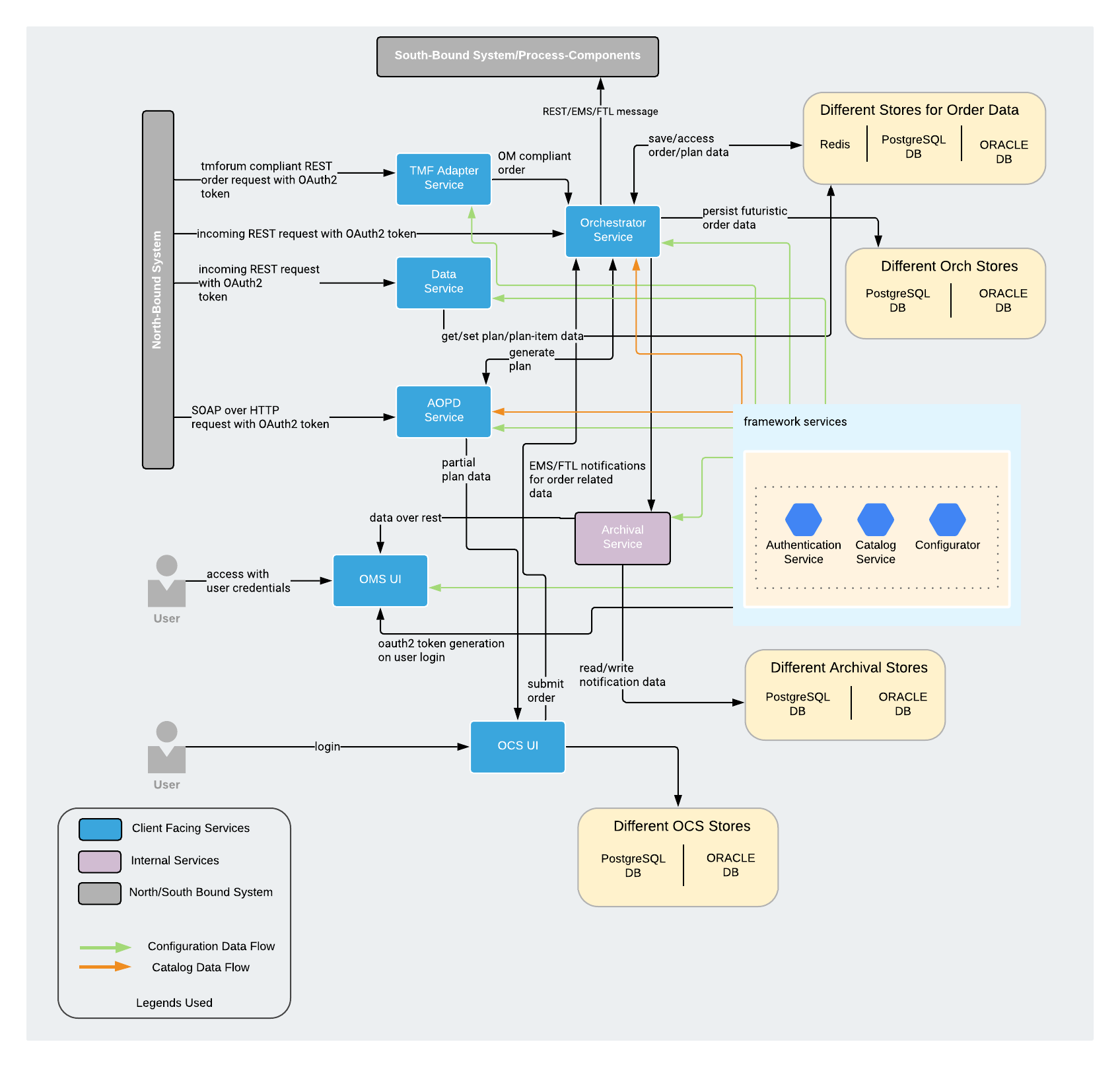Architecture
TIBCO Order Management is made of several components. Each component has a particular role.
The major components of TIBCO Order Management include:
- Orchestrator: Orchestrator exposes REST HTTP services that can be used to submit the orders. Orchestrator takes the order plan from Automatic Order Plan Development and executes those tasks till completion. It invokes micro-level process plan fragments to initiate tasks within the operator's operations ecosystem, enabling appropriate actions in a variety of back-end systems (for example, billing systems, network systems, scheduling systems, and so on). Orchestrator keeps track of status and manages exceptions.
- Automatic Order Plan Development (AOPD): Valid orders accepted by the Order Management System are decomposed into their individual products, services, and resources. An optimized order plan workflow process is then generated based on those basic building blocks to ensure an accurate order fulfillment. Optimization can take into account both product rules and customer inventory and other data to arrive at the final order plan.
- Authentication: A JSON Web Token-based authorization has been introduced for the Order Management System REST web service by using JSON Web Token (JWT). The Authorization Service has been added to get the token based on the user name and password. This token can be used to access other operations of the order services.
Note:
- Authentication service is a primary service that does not depend on any other service to start.
- The Order Management System UI and Configurator UI requires the authentication service to always be up and running. The credentials entered on the UI by users are validated by the authentication service. On successful validation, tokens are generated. These tokens are then used by the Order Management System UI and Configurator UI to initiate the login process.
- Data Service: Data Service is used to add, update, or modify the User Defined Fields at the plans and plan items level. There are two types of data services.
- Catalog Service: This REST service is used to load the product and plan fragment data models over HTTP.
- TM Forum Adapter Service: TM Forum Adapter is an implementation for TMF622 API specification. It acts as a bridge between the TM Forum Specification and the TIBCO Order Management system. TM Forum Adapter Service exposes REST over HTTP/HTTPS services, which can be used to query productOrder. TM Forum Adapter Service captures the productOrder and submits it to Order Management System as order request.
- Order Capture System (OCS): It is a web application component with a UI to create, manage, and submit TIBCO Fulfillment Orchestration Suite orders based on what a subscriber already has. With Order Capture System, you can select subscribers and browse validated products, services, or bundles from TIBCO Product and Service Catalog. Order Capture System interacts with the runtime model server, which handles data, synchronizes it with all systems, and monitors the life cycle of the shopping cart.
There are additional components, which are explained in more detail in TIBCO Order Management User's Guide. Here are few of those additional components:
- Order Management System User Interface (OMSUI): Provides operators a GUI to manage and track orders. Order Management System persists order data and operators can use it to search, view, track, and trace orders. The users can take actions on order or order lines.
- Common Logging: All TIBCO Order Management components report to a common logging component for the ease of maintenance and operations management of the system.
- Order Management - Migration: It performs migration of orders from data source of TIBCO Order Management - Long Running 5.0.0 HF2 version to TIBCO Order Management 5.1.0 version. For the non-final state orders, the data are migrated to both the Archival database and the Redis database. Further requests to process these orders are sent to Orchestrator. Orders in the final state are migrated only to the Archival database.
- Archival Service: It acts as the data backup for Orchestrator and it uses FTL messages to achieve this. For every status change in the order, Orchestrator sends a FTL message. Archival receives that message and save the required information in a database. After the order reaches final state, it gets entire order information (such as order data, plan data, audit data) and saves it in the database. It exposes REST HTTP GET services to read this information. The Order Management System UI contacts Archival to get the information it requires.

Copyright © 2021. Cloud Software Group, Inc. All Rights Reserved.

